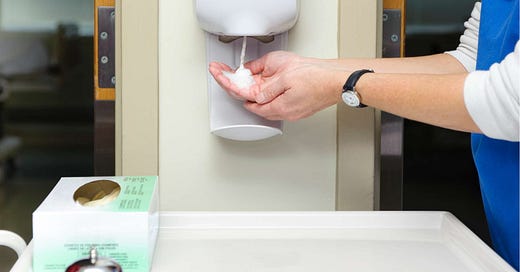Did you know that some healthcare workers may need to clean their hands as often as 100 times per shift to keep themselves and others safe? In order to prevent the spread of infections, we know hand hygiene is a critical practice. However, despite the direct impact this has on patient safety, it’s still challenging to get people to comply with hand hygiene requirements.
In order to study how messaging might motivate behavior change and improve hand hygiene compliance, researchers conducted an experiment. They randomly assigned one of three signs to be posted above hospital soap dispensers and hand-sanitizing gel dispensers. The signs read:
“Hand hygiene prevents you from catching diseases.”
“Hand hygiene prevents patients from catching diseases.”
“Gel in, wash out.”
Traditionally, hospitals have approached hand hygiene initiatives by emphasizing personal consequences, and this strategy was represented by the standard message: “Hand hygiene prevents you from catching diseases.” Alternatively, in the patient-focused message, “Hand hygiene prevents patients from catching diseases,” the researchers merely changed one word. However, this meaningfully shifted the core of the message from self-protection to patient safety. The control sign, “Gel in, wash out,” was developed by hospital managers.
The results were striking. After the signs were posted, the amount of hand-hygiene product that was used from dispensers with the patient-focused message was significantly greater than the amount used from the dispensers with either the control sign or the sign that emphasized personal consequences. This suggests that healthcare workers are more motivated to clean their hands when they’re reminded that it’s instrumental in keeping patients safe.
This research demonstrates that in order for a message to be effective, it’s important to frame the message in a way that aligns with the values and motivations of the target audience. For example, framing the message around patient well-being evokes empathy and compassion, which are powerful motivators in healthcare. Reminding healthcare workers that hand hygiene is essential for patient safety also taps into their sense of ethical responsibility and the intrinsic motivation to do no harm.
By shifting the focus from self-protection to patient safety, hospitals and other healthcare facilities can ultimately improve patient outcomes by increasing compliance with hand hygiene requirements. This simple yet effective strategy demonstrates the power of intentional word choice and thoughtful communication in promoting health and safety.




